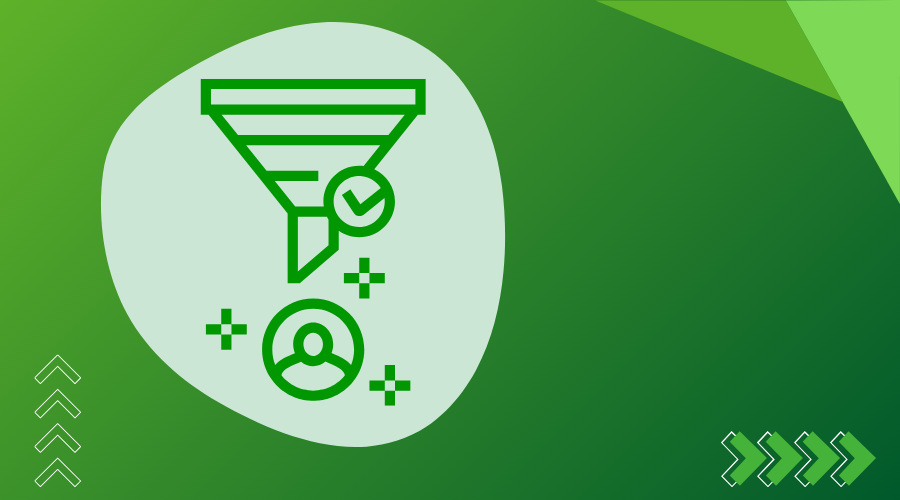If you’ve ever wasted time chasing a lead that never had the budget, authority, or real intent to buy, you know how frustrating it can be. That’s where lead qualification comes in. Lead qualification is the process of figuring out which prospects are worth your time and which ones aren’t. Whether you’re running a marketing campaign or handling sales calls, understanding what is lead qualification and how it works is one of the most important steps in building a healthy sales pipeline.
In this guide, we’ll walk through everything you need to know about sales lead qualification. From types of qualified leads, to the step-by-step process, to frameworks and a practical lead qualification checklist, you’ll learn how to stop wasting time on bad prospects and focus on the ones most likely to convert.
Related: How to Get More Qualified Leads for Your B2B Business
What is Lead Qualification?
Lead qualification is the process of determining whether a potential customer has the intent, budget, authority, and timeline to buy from you. Not every lead is created equal. Some are simply browsing, some are collecting quotes for the future, and some are ready to sign tomorrow.
The qualification process helps you identify where a lead falls in that journey. By asking the right questions, gathering the right data, and following a consistent framework, you can filter out unqualified leads and prioritize the ones that have the highest chance of becoming paying customers.
Think of lead qualification as a filter that protects your team’s time. Instead of chasing every form submission, phone call, or inbound inquiry, your team uses clear criteria to decide which leads are worth pursuing. This means sales is talking to the right people at the right time, and marketing is generating leads that actually convert.
A strong qualification process also creates consistency. If every rep on your team defines “qualified” differently, your pipeline becomes unpredictable and full of false confidence. But with a clear standard in place, everyone knows what a good lead looks like and how to handle it.
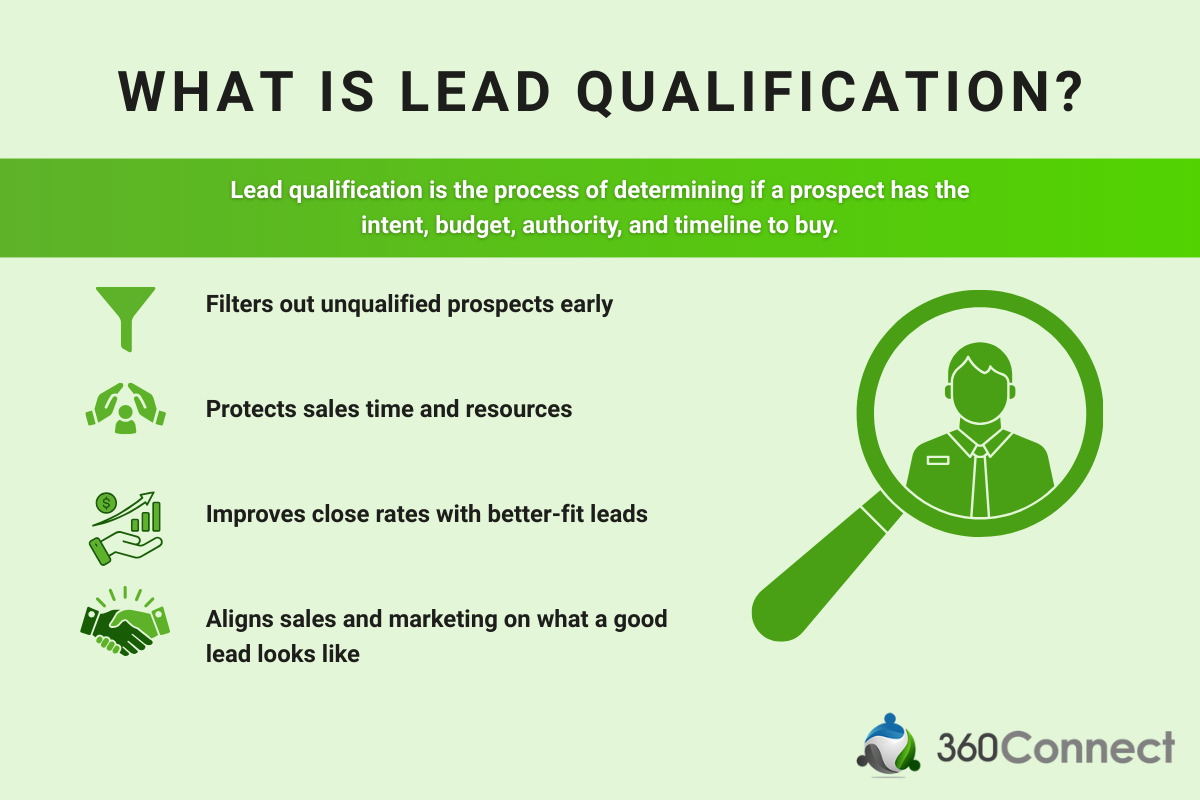
Why is Lead Qualification Important?
Lead qualification is important because it allows businesses to focus on prospects that have real buying potential, saving time, reducing costs, and increasing close rates. Without it, sales teams end up chasing deals that were never going to close, leading to frustration, wasted resources, and missed revenue opportunities.
Saves Time & Resources
Every sales rep has limited hours in the day. If they spend that time chasing low-quality leads, they’re burning energy that could be invested in deals that actually close. For example, imagine a rep spends two weeks nurturing a lead, only to find out the company doesn’t even have the budget to buy. Qualification ensures reps filter those leads upfront and prioritize the ones worth their time.
Salesforce reports that reps spend just 28% of their week actively selling. Which makes it even more important to filter out unqualified leads and give that time back to real opportunities.
Improves Close Rates
Qualified leads are far more likely to convert. When someone has the budget, decision-making power, and an urgent need, the odds of winning the deal skyrocket. This isn’t just anecdotal, research shows that companies using structured qualification see up to 30% higher close rates compared to those that don’t.
Related: How to Close a Sales Deal
Aligns Sales and Marketing
Marketing generates interest, but sales needs to know which of those leads are truly viable. Without qualification, sales often complains that marketing is sending “bad leads,” while marketing insists sales isn’t following up. A shared qualification process builds alignment. Both teams know what a “good lead” looks like and can work together more smoothly.
Related: Aligning Sales and Marketing to Generate Quality Leads
Shortens the Sales Cycle
Chasing cold leads drags out the process. Qualified leads move faster because they already meet key requirements. For example, a qualified lead might request a quote today and sign within a week, while an unqualified lead drags you along for months before disappearing.
Related: Understanding the B2B Sales Cycle
Increases ROI
Marketing budgets are too valuable to waste. By focusing campaigns on attracting prospects that fit your ideal profile, every dollar goes further. Instead of casting a wide net and hoping something sticks, you’re deliberately investing in leads that are more likely to buy.
In other words, without marketing lead qualification, you’re essentially throwing darts in the dark. With it, you’re aiming at a clear target and consistently hitting more bullseyes.
Related: The Complete R.O.I. Guide to 360Connect’s Revenue Growth Program
Common Types of Qualified Leads
Not all qualified leads look the same. Businesses often classify them into different categories depending on how far along they are in the buying journey. Each type requires its own approach to nurture them effectively.
Marketing Qualified Lead (MQL)
An MQL is a lead that has engaged with your marketing but isn’t ready for direct sales yet. They’ve shown interest, but they still need education and nurturing. Examples include downloading a whitepaper, signing up for a newsletter, or attending a webinar. These actions show intent, but not urgency.
For suppliers, MQLs are valuable because they represent the top of your funnel. They’re often in research mode, trying to understand their options before making a decision. If you rush them to sales, you’ll likely scare them off. Instead, marketing teams use nurture campaigns, content, and drip emails to build trust and guide MQLs toward being ready.
Signs of an MQL:
- Engages with your website or content
- Signs up for a webinar or resource
- Clicks links in your email campaigns
- Interacts on social media but hasn’t requested pricing yet
Sales Qualified Lead (SQL)
An SQL is further along in the funnel and shows clear buying intent. They’re ready to engage with a sales rep. Examples include requesting a demo, asking for a quote, or directly reaching out to discuss solutions.
These leads are the most valuable for your sales team because they’ve already taken steps that show urgency. If you don’t act quickly, a competitor will. Suppliers often find that SQLs convert at the highest rate, but only if the handoff between marketing and sales is handled properly.
Signs of an SQL:
- Requests pricing or a demo
- Engages with sales reps directly
- Clearly defines their problem and timeline
- Fits your ideal customer profile
Product Qualified Lead (PQL)
A PQL comes from product-driven businesses, often in SaaS. These are users who have already tried your product, usually through a free trial or freemium version, and are showing behaviors that signal readiness to upgrade. For example, someone using a free CRM who keeps hitting the limits of the free plan.
PQLs are powerful because they’ve already experienced your product’s value firsthand. Instead of needing to be convinced, they just need a push at the right moment. Suppliers can identify PQLs by tracking usage data and spotting patterns that indicate buying intent.
Signs of a PQL:
- Actively using your free trial or freemium product
- Engaging with premium features but not yet paying
- Asking about pricing or limits on the free plan
- Repeatedly logging in and relying on the tool
Service Qualified Lead (SQL/ServiceQL)
A Service Qualified Lead is a customer who has indicated they’re ready to buy more or upgrade a service. For example, an existing copier leasing client reaching out to ask about upgrading to a newer model, or a SaaS customer contacting support about moving to a higher plan.
These leads are gold because they’re already customers. The trust is built, and the upsell conversation is much easier than winning new business. Customer success teams often manage ServiceQLs, but they’re a crucial part of growth strategy.
Signs of a ServiceQL:
- Existing customer asks about upgrades
- Inquires about additional products or features
- Demonstrates growing usage needs
- Contacts support about expanding service
How Does Lead Qualification Work?
Lead qualification works by collecting information about a prospect and evaluating whether they fit your ideal customer profile and have the intent to buy. It’s essentially a filtering process that prevents your team from wasting time on prospects who were never serious to begin with.
The process usually starts with an initial point of contact. A lead might fill out a form on your website, call in, respond to an ad, or meet you at an event. At that point, you know they’re interested, but you don’t yet know how serious they are.
The next step is gathering information. This can include their company size, industry, budget, timeline, and specific pain points. You can collect this data through forms, discovery calls, surveys, or digital tracking. The more accurate the data, the easier it is to determine if they’re worth pursuing.
Once you have enough information, you can score or filter the lead. High-fit, high-intent leads get fast-tracked to sales. Leads that show interest but aren’t ready yet might be placed into a nurture campaign. Leads that don’t fit at all should be disqualified quickly so they don’t clutter the pipeline.
In short, lead qualification works by asking the right questions early, organizing the answers consistently, and routing leads based on fit and readiness. This keeps your sales process sharp and focused.
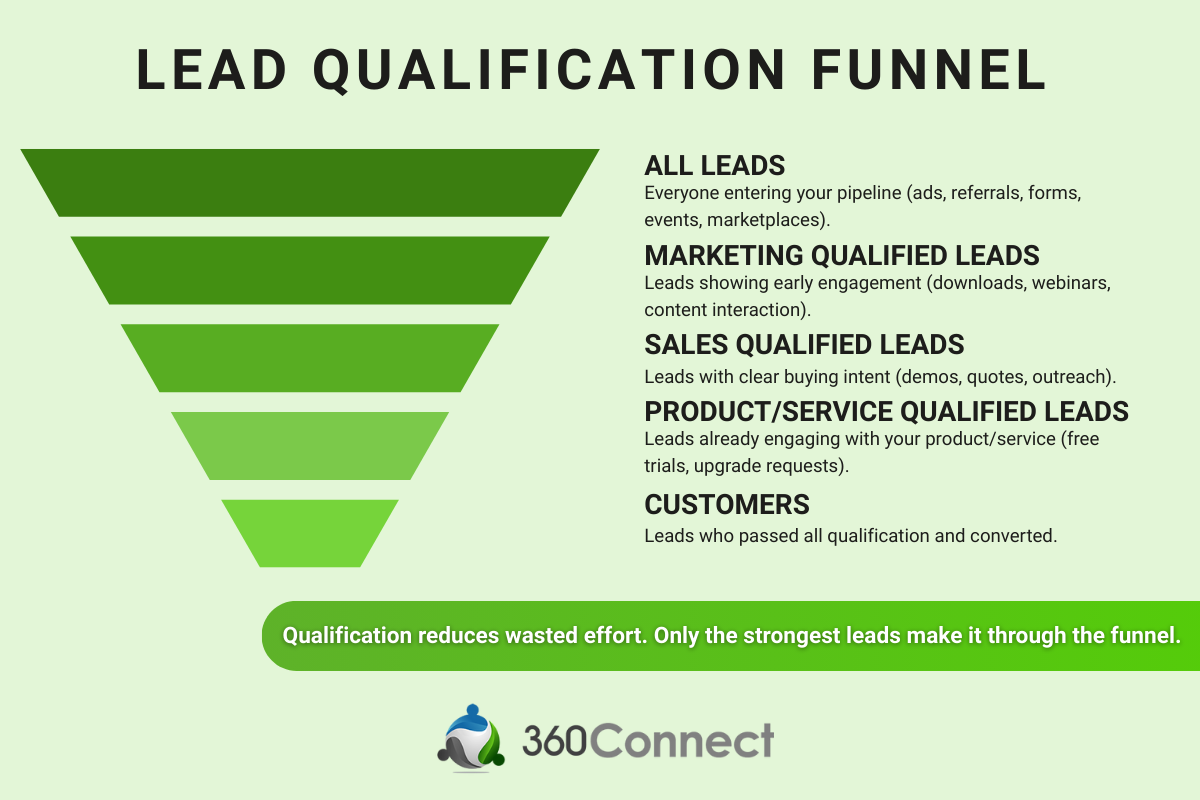
Lead Qualification Process: Step-by-Step
Every company’s sales process looks a little different, but the steps for qualification tend to follow a similar pattern. Here’s a detailed breakdown:
Step 1: Define Your Ideal Customer Profile (ICP)
Before you can qualify leads, you need to know who you’re looking for. An ICP outlines the type of companies that are the best fit for your product or service. This includes details like industry, company size, location, budget range, and common pain points. Without an ICP, your qualification process will feel random and inconsistent.
What to include in your ICP:
- Industry or verticals you serve best
- Typical company size or revenue range
- Geographic areas you can realistically support
- Pain points your solution solves consistently
Step 2: Capture Leads Through Marketing Channels
Once your ICP is defined, the next step is generating leads that match it. These might come from inbound marketing (website forms, ads, SEO), outbound campaigns (calls, emails), trade shows, or online B2B marketplaces. Capturing leads in multiple ways ensures you have a steady stream of prospects entering your funnel.
Common lead capture sources:
- PPC ads driving to landing pages
- Trade shows and conferences
- B2B marketplaces and directories
- Referral and partner networks
Related: Benefits of Online B2B Marketplaces
Step 3: Gather Information
Not all leads volunteer the details you need upfront. Use forms, surveys, or early discovery calls to gather critical data. Questions about budget, decision-making authority, and timelines help you quickly determine if they’re qualified. The more structured your data collection is, the easier it becomes to compare leads.
Key information to collect:
- Budget or spending authority
- Decision-maker vs. influencer role
- Pain points or challenges
- Urgency of the purchase
Step 4: Score Leads
Lead scoring assigns a value to each lead based on how well they match your ICP and how much intent they’ve shown. This helps your team separate hot opportunities from those that need more time. A strong scoring system makes it easier to prioritize and route leads consistently.
How to score leads effectively:
- Assign points for engagement (downloads, form fills, demos)
- Weigh ICP fit more heavily than casual interactions
- Use scoring ranges (e.g., 0–25 = cold, 26–75 = nurture, 76–100 = sales-ready)
- Automate scoring through your CRM whenever possible
Step 5: Disqualify Leads That Don’t Fit
Not every lead is worth pursuing, and that’s okay. Disqualification is just as important as qualification because it keeps your pipeline accurate. By removing unfit leads early, you avoid wasting resources and keep reps focused on real opportunities.
Common disqualification reasons:
- Out-of-budget prospects
- Leads outside your target industry
- Students, job seekers, or researchers posing as buyers
- Prospects with unrealistic timelines
Step 6: Pass Qualified Leads to Sales
Once a lead reaches the right score or meets the agreed-upon criteria, it’s handed off to sales. At this point, sales can engage confidently knowing the lead has already been vetted. A smooth handoff process prevents leads from slipping through the cracks.
Best practices for sales handoff:
- Trigger handoff when the scoring threshold is met
- Share all collected data to avoid duplicate questions
- Establish SLAs (service-level agreements) for fast follow-up
- Track conversion rates to validate qualification criteria
Step 7: Continuous Feedback Loop
Lead qualification isn’t something you set once and forget. Your market evolves, buyer behavior changes, and sales feedback should always influence how you define “qualified.” A continuous loop between sales and marketing keeps your process sharp.
Ways to maintain feedback alignment:
- Review closed deals to see which factors made them qualified
- Adjust scoring rules based on sales input
- Identify recurring traits in disqualified leads
- Update ICPs as your target market shifts
Related: What is 360Connect’s Lead Verification Process?
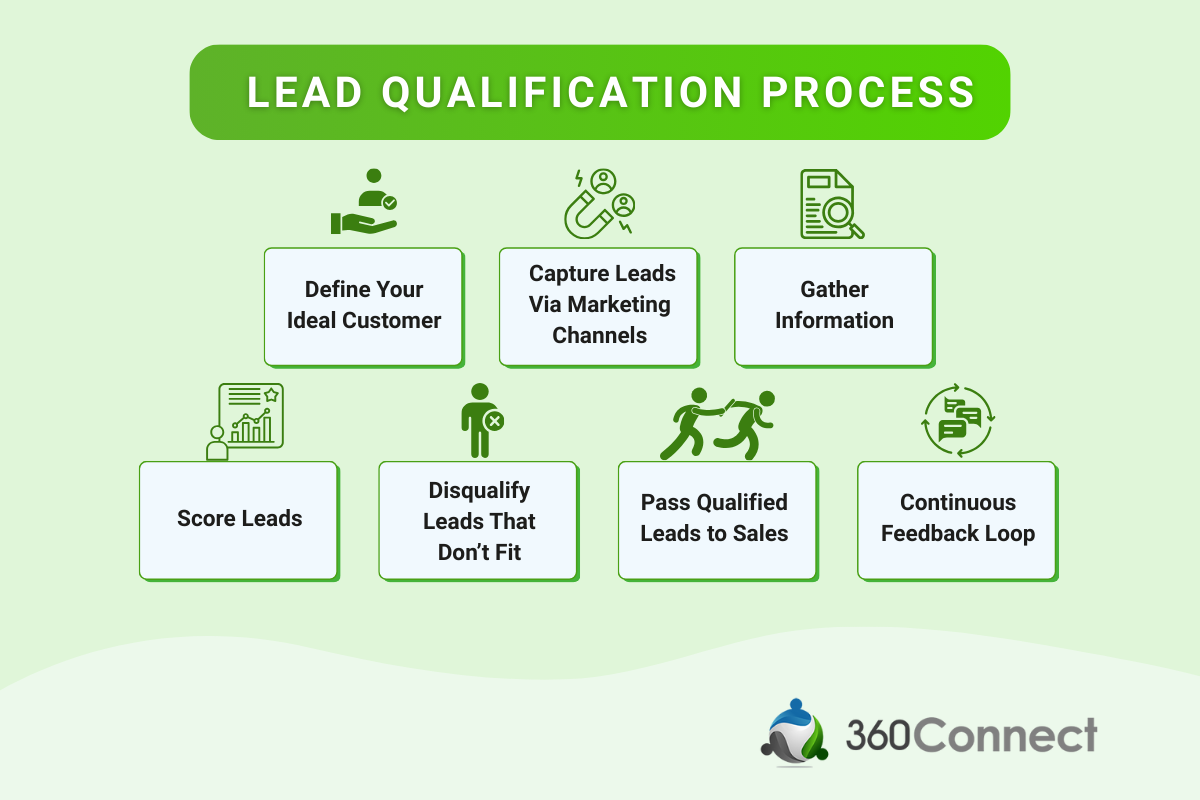
Lead Qualification Frameworks
To keep qualification consistent, many companies use established frameworks. These are essentially guidelines that reps can follow to make sure they’re asking the right questions. Here are the most common ones:
BANT
BANT stands for Budget, Authority, Need, and Timeline. It’s one of the oldest and most widely used qualification frameworks.
- Budget: Does the lead have the money to buy?
- Authority: Are you speaking to a decision-maker?
- Need: Does the lead actually need what you’re selling?
- Timeline: How soon do they plan to purchase?
BANT is straightforward and effective because it covers the basics. If a lead can check all four boxes, they’re highly qualified. However, some argue that BANT can feel rigid, especially if a buyer has a need but hasn’t finalized budget yet.
CHAMP
CHAMP stands for Challenges, Authority, Money, and Prioritization. It’s a modern alternative to BANT that puts the buyer’s problems first.
- Challenges: What pain points is the prospect trying to solve?
- Authority: Who is making the decision?
- Money: Can they afford your solution?
- Prioritization: Where does this problem fall on their list of priorities?
CHAMP is useful for suppliers because it emphasizes understanding the customer’s challenges before pushing a sale. It helps you avoid wasting time on prospects who don’t view the problem as urgent.
MEDDIC
MEDDIC is more complex and is often used in enterprise sales. It stands for Metrics, Economic Buyer, Decision Criteria, Decision Process, Identify Pain, and Champion.
- Metrics: What measurable results are they seeking?
- Economic Buyer: Who controls the budget?
- Decision Criteria: What factors will they use to choose a vendor?
- Decision Process: How will they make the decision internally?
- Identify Pain: What problem needs solving?
- Champion: Is there someone internally pushing for your solution?
MEDDIC is powerful because it digs deep into the buying process. For high-ticket sales, this framework helps you understand not just the buyer’s need, but the internal politics and processes that will make or break the deal.
ANUM
ANUM stands for Authority, Need, Urgency, and Money. It’s a simplified version of BANT that prioritizes authority first.
- Authority: Are you speaking to the decision-maker?
- Need: Is there a clear problem you can solve?
- Urgency: How quickly do they want a solution?
- Money: Do they have the budget?
ANUM works well when you need to quickly filter leads. By prioritizing authority, you avoid wasting time with people who don’t have the power to make a decision.
Lead Qualification Checklist
If you want a practical way to qualify leads quickly, use a checklist. Here’s one you can adapt to your business:
- Does the lead fit your target industry?
- Is the company the right size for your solution?
- Do they have the budget to purchase?
- Are you talking to a decision-maker or influencer?
- Have they expressed a clear pain point you can solve?
- Do they have a realistic timeline to buy?
- Have they engaged with your marketing or sales content?
- Do they meet your internal lead scoring threshold?
If most of these boxes are checked, the lead is worth pursuing. If not, they may need more nurturing before being passed to sales.
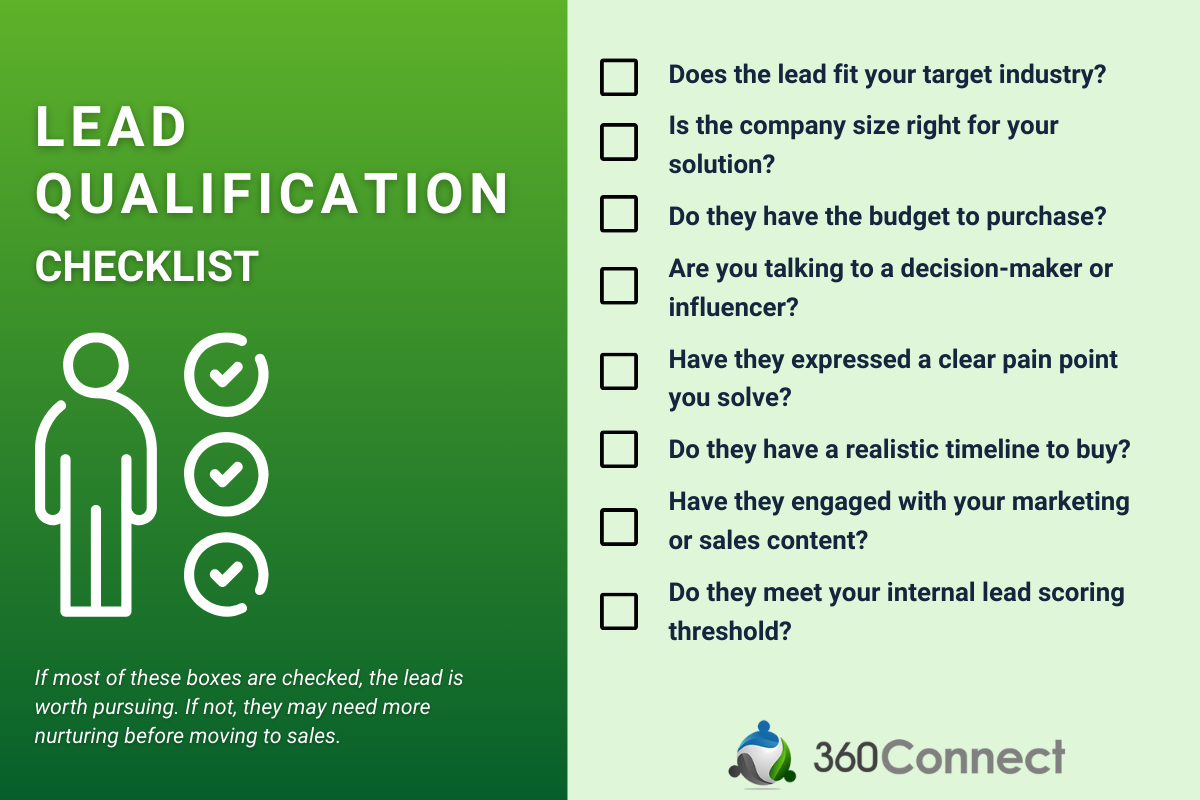
Who Uses Lead Qualification?
Lead qualification isn’t just a sales tactic. It’s used across different teams in an organization to make sure time, money, and effort are being spent wisely. Each department has its own reasons for using lead qualification, and when everyone works together, the entire growth engine runs more smoothly.
Marketing Teams
For marketing, lead qualification is about quality over quantity. It’s not enough to generate a huge pile of leads if most of them don’t convert, marketing looks ineffective. By qualifying leads early, marketing can decide which prospects are worth passing to sales and which should be nurtured longer.
- Helps marketing prove ROI by showing they’re delivering real opportunities, not just clicks
- Keeps the relationship with sales strong by avoiding the “bad leads” complaint
- Ensures ad spend and campaign dollars are focused on attracting the right audience
- Builds a clean handoff process so no lead falls through the cracks
Sales Teams
Sales lives and dies by lead qualification. A sales rep who spends 80% of their day chasing bad leads will burn out quickly. With qualification, they can focus on conversations that actually have a chance of turning into deals. This shortens the sales cycle, boosts morale, and drives more predictable revenue.
- Helps reps prioritize their pipeline based on urgency and fit
- Saves time by cutting out unqualified leads before discovery calls drag on
- Improves forecasting accuracy since the pipeline reflects real opportunities
- Gives sales confidence they’re chasing deals worth their effort
Customer Success Teams
Qualification doesn’t stop after a deal closes. Customer success teams use it when identifying upsell or cross-sell opportunities. For example, if a customer hints that they’re expanding their business, CSMs can qualify that signal as an opportunity for additional products or upgraded services.
- Detects expansion opportunities within existing accounts
- Helps spot churn risks if a customer no longer fits the ideal profile
- Guides upsell conversations by focusing on accounts that are both ready and able to expand
- Ensures customer success contributes to revenue growth, not just retention
Executives & Leadership
Executives care about qualification because it drives revenue forecasting and resource planning. A pipeline filled with unqualified leads gives leadership false confidence. A qualified pipeline, on the other hand, gives them clarity to plan hiring, budgets, and growth strategies.
- Provides accurate revenue forecasts for board reporting
- Helps allocate resources where they’ll drive the most impact
- Identifies which markets or buyer segments are worth doubling down on
- Increases investor or stakeholder confidence by showing a disciplined growth process
In other words, everyone who touches the buyer journey benefits from lead qualification. It creates alignment across teams and ensures that growth isn’t left to chance.
Benefits of Lead Qualification
When done right, lead qualification doesn’t just help sales close more deals. It transforms the way a business grows. Here are the biggest benefits and why they matter to suppliers:
Higher Conversion Rates
The most obvious benefit is more deals. Qualified leads already have the right budget, authority, and intent, which makes them much more likely to convert. Instead of chasing 100 random prospects to land one sale, you could chase 20 qualified leads and close five.
- Increases win rates by focusing on prospects that already fit your ICP
- Reduces the “feast or famine” cycle of unpredictable sales
- Makes your sales team more efficient, closing more deals without hiring more reps
Shorter Sales Cycles
Qualified leads move faster. If a buyer already has budget approval, knows their pain points, and is actively seeking a solution, you skip weeks or months of back-and-forth. This means more deals closed in less time, which compounds into more revenue.
- Cuts wasted time on leads that were never serious to begin with
- Moves buyers straight into quoting and contracting stages
- Frees reps to handle more opportunities per month
- Improves customer experience because buyers get faster answers
Better Sales & Marketing Alignment
One of the biggest friction points in most businesses is the disconnect between marketing and sales. Marketing says, “We gave you leads,” and sales says, “They’re all junk.” Lead qualification fixes this by creating shared criteria. Both teams agree on what makes a good lead, which keeps the pipeline healthy.
- Reduces finger-pointing and builds trust across teams
- Helps marketing refine campaigns based on sales feedback
- Ensures leads are consistently nurtured before they’re handed off
- Creates a smoother buyer journey from first click to signed deal
More Efficient Use of Resources
Every company has limits, whether it’s budget, staff, or time. Lead qualification makes sure those resources are focused where they’ll have the biggest impact. Instead of wasting $10,000 on ads that generate random clicks, you spend that same money targeting buyers who actually convert.
- Increases ROI on marketing campaigns
- Keeps sales reps from burning out on dead-end conversations
- Helps leadership justify investments in tools, ads, and headcount
- Avoids bloated pipelines full of “noise” that never closes
Improved Customer Experience
Qualification isn’t just good for you, it’s good for the buyer too. Nobody likes being pressured to buy when they’re not ready. By qualifying leads, you can meet prospects where they are and engage at the right level. That builds trust and long-term relationships.
- Prevents aggressive sales tactics on unready buyers
- Builds stronger relationships by respecting the buyer’s timeline
- Makes buyers feel understood because their challenges are validated
- Leads to repeat business and referrals from happy customers
Final Thoughts on Lead Qualification
Lead qualification may sound like another sales buzzword, but it’s one of the most powerful ways to improve your pipeline. By understanding what is lead qualification, creating a clear process, and using frameworks and checklists, you can stop wasting time on the wrong prospects and focus on the ones that truly matter.
If your team struggles with long sales cycles, low conversion rates, or wasted marketing spend, a structured qualification process could be the solution.
Get Qualified Leads Daily
At 360Connect, we connect suppliers with real, high-intent buyers who are already looking for solutions. Instead of hunting for opportunities, you can join our supplier network and start receiving qualified leads daily that match your product, location, and industry.
Ready to grow your business with a steady flow of leads?

